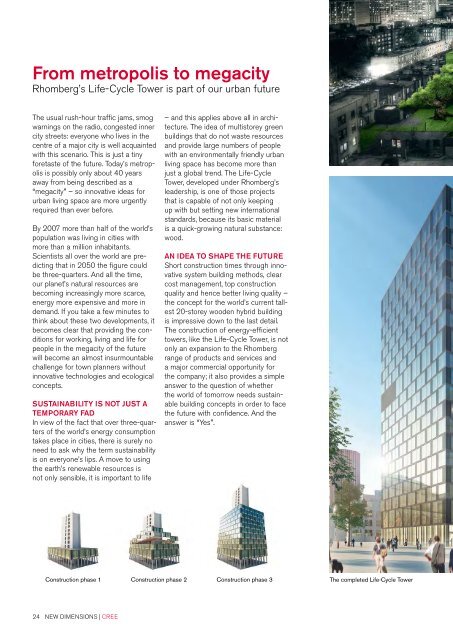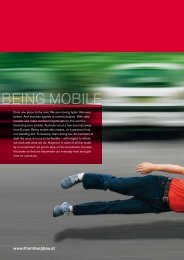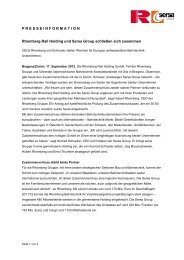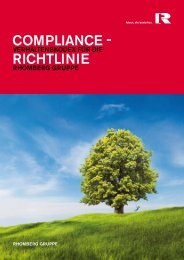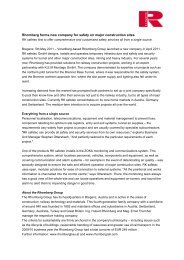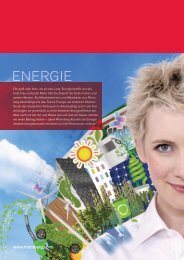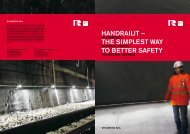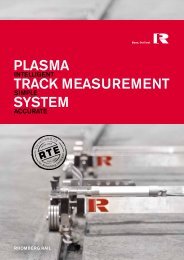New Dimensions 2011 - Rhomberg Bau
New Dimensions 2011 - Rhomberg Bau
New Dimensions 2011 - Rhomberg Bau
Create successful ePaper yourself
Turn your PDF publications into a flip-book with our unique Google optimized e-Paper software.
From metropolis to megacity<br />
<strong>Rhomberg</strong>’s Life-Cycle Tower is part of our urban future<br />
The usual rush-hour traffic jams, smog<br />
warnings on the radio, congested inner<br />
city streets: everyone who lives in the<br />
centre of a major city is well acquainted<br />
with this scenario. This is just a tiny<br />
foretaste of the future. Today’s metropolis<br />
is possibly only about 40 years<br />
away from being described as a<br />
“megacity” – so innovative ideas for<br />
urban living space are more urgently<br />
required than ever before.<br />
By 2007 more than half of the world’s<br />
population was living in cities with<br />
more than a million inhabitants.<br />
Scientists all over the world are predicting<br />
that in 2050 the figure could<br />
be three-quarters. And all the time,<br />
our planet’s natural resources are<br />
becoming increasingly more scarce,<br />
energy more expensive and more in<br />
demand. If you take a few minutes to<br />
think about these two developments, it<br />
becomes clear that providing the conditions<br />
for working, living and life for<br />
people in the megacity of the future<br />
will become an almost insurmountable<br />
challenge for town planners without<br />
innovative technologies and ecological<br />
concepts.<br />
sUstainability is not just a<br />
temporary fad<br />
In view of the fact that over three-quarters<br />
of the world’s energy consumption<br />
takes place in cities, there is surely no<br />
need to ask why the term sustainability<br />
is on everyone’s lips. A move to using<br />
the earth’s renewable resources is<br />
not only sensible, it is important to life<br />
– and this applies above all in architecture.<br />
The idea of multistorey green<br />
buildings that do not waste resources<br />
and provide large numbers of people<br />
with an environmentally friendly urban<br />
living space has become more than<br />
just a global trend. The Life-Cycle<br />
Tower, developed under <strong>Rhomberg</strong>’s<br />
leadership, is one of those projects<br />
that is capable of not only keeping<br />
up with but setting new international<br />
standards, because its basic material<br />
is a quick-growing natural substance:<br />
wood.<br />
An idea to shape the future<br />
Short construction times through innovative<br />
system building methods, clear<br />
cost management, top construction<br />
quality and hence better living quality –<br />
the concept for the world’s current tallest<br />
20-storey wooden hybrid building<br />
is impressive down to the last detail.<br />
The construction of energy-efficient<br />
towers, like the Life-Cycle Tower, is not<br />
only an expansion to the <strong>Rhomberg</strong><br />
range of products and services and<br />
a major commercial opportunity for<br />
the company; it also provides a simple<br />
answer to the question of whether<br />
the world of tomorrow needs sustainable<br />
building concepts in order to face<br />
the future with confidence. And the<br />
answer is “Yes”.<br />
Construction phase 1 Construction phase 2 Construction phase 3<br />
The completed Life-Cycle Tower<br />
24 NEW DIMENSIONS | CREE


